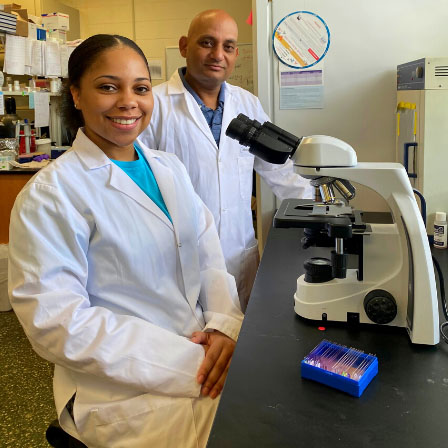Ticks and Lyme Disease: USM Researchers Co-Author Paper That Examines microRNAs in Ticks
Thu, 07/14/2022 - 02:22pm | By: Ivonne Kawas
 According to recent estimates reported to the Center for Disease Control and Prevention,
cases of Lyme disease have rapidly increased in the United States to more than 476,000
annually, and healthcare-related costs exceed $1 billion annually.
According to recent estimates reported to the Center for Disease Control and Prevention,
cases of Lyme disease have rapidly increased in the United States to more than 476,000
annually, and healthcare-related costs exceed $1 billion annually.
Most cases of Lyme disease in the U.S. are due to the spirochete bacteria Borrelia burgdorferi sensu stricto transmitted by bite of a black-legged tick Ixodes scapularis.
A research paper recently published in the International Journal of Molecular Sciences by researchers at The University of Southern Mississippi (USM) opens up a new area of study: to explain the functional role of MicroRNAs (miRNAs) in tick biology and tick-pathogen-host interactions.
miRNAs, a small non-coding RNA molecule that contains 19-25 nucleotides in length that regulate posttranscriptional gene expression, are predicted to have a role in tick immunity and can aid scientists in understanding the process of how the disease is developed.
The lead author of this study, Dr. Deepak Kumar, postdoctoral researcher in USM’s Center for Molecular and Cellular Biosciences, and collaborators published new insights in the paper titled: “Identification of microRNAs in the Lyme Disease Vector Ixodes scapularis,” as they examined the potential of manipulating the novel class of tick miRNAs.
The team of researchers note that miRNAs have tremendous potential to regulate cellular processes, including immune pathways within the tick to control bacterial, parasitic, and viral infections; however, there has been limited data on differentially expressed miRNAs in the black-legged tick after infection with the spirochete bacteria.
In the study, they identified that miRNAs differentially expressed in Borrelia burgdorferi-infected ticks. They explain that the potential of manipulating the novel class of tick miRNAs in the context of Borrelia transmission will likely aid in developing tick-borne pathogen control strategies that can pave the way to prevent or treat the infection.
Collaborators included Latoyia Downs, graduate student in USM’s School of Biological, Environmental, and Earth Sciences; Dr. Monica Embers, associate professor of microbiology and immunology division of immunology at Tulane National Primate Research Center; and professors in USM’s Center for Molecular and Cellular Biosciences Dr. Alex Flynt and Dr. Shahid Karim.
The researchers sequenced, assembled, and annotated tick miRNAs, a key informative dataset enabling insights into molecular adaptations of Borrelia burgdorferi to survive in Ixodes scapularis. The team added >254 new and novel miRNAs to the existing database.
“Tick-borne diseases are rising due to climatic changes and are predicted to increase,” said co-author Dr. Karim. “The increase in tick-borne diseases is a significant threat to public health in the absence of preventive measures. The field of tick miRNAs is primarily neglected and unexplored. This work is the tip of the iceberg, as it opens up a new avenue to exploit the full potential of miRNAs in ticks.”
The International Journal of Molecular Sciences is an international, peer-reviewed, open access journal providing an advanced forum for biochemistry, molecular and cell biology, molecular biophysics, molecular medicine, and all aspects of molecular research in chemistry, and is published semimonthly online by MDPI. Its affiliates include The Australian Society of Plant Scientists (ASPS), Epigenetics Society, European Calcium Society (ECS), European Chitin Society (EUCHIS), Spanish Society for Cell Biology (SEBC) and others.
The research was published in a special issue of the journal, Molecular Biology of Disease Vectors. Read the paper.